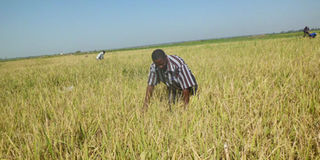Empowering rural farmers with technologies for improved yields

Rice farm in Doho where farmers apply fertilizer to improve yields. Photo by Lominda Afedraru.
What you need to know:
- Dr Roselline Nyamutale, the country director, Sasakawa Global 2000, explains how farmers can improve their yields, writes Lominda Afedraru.
Smallholder farms dominate African agriculture, and most of them continue to employ traditional cultivation techniques but experts from the Sasakawa Global 2000 ask farmers to employ better farm technologies to solve the problem of food security by looking at the full length of the value chain. That means supporting producers by improving productivity and processing, and increasing market access as a means of enhancing added value and fostering farmers’ income.
In an interview, Dr Roselline Nyamutale, the country director Sasakawa Global 2000, said the organisation focuses on sensitising farmers on best practices and was created to alleviate regional reliance on food aid.
Nyamutale explained that the organisation has been working with farmers in about 60 districts in the country targeting smallholder farmers growing cereal crops like maize, rice, sorghum, legume crops like beans, groundnuts, and cowpeas and tubers such as cassava and sweet potato.
The team works with organised farmer groups, sensitising them right from land preparation, space planting, weeding and pest and disease management.
Usually this is done by setting demonstration farms for every organised farmer group and technology option for fertiliser use plus application of seed in a given farm is key to attain improved yield.
Land preparation
For the case of farmers growing maize, they are advised to plant by spacing 75cm by 60cm and two seeds per hole. In applying fertiliser like DAP, farmers are advised to use soda bottle for measurement in every hole and when the crop has grown farmers are advised to mix the fertiliser with water and apply around the plant. This should be done when weeding is already done. Korn-Kali fertilizer is advisable for farmers growing maize to use and this has to be applied after 15 days of planting.
Dr Nyamutale explains that in land preparation, different farmers use different tools. Some use tractors, others hoes and while others ox plough. She emphasises the need to till land and leave it for about two weeks before planting.
For all cereal crops and legumes, weeding should be done two weeks after planting and a second weeding when the plants are flowering.
However this is done vis-a-vis the usual methods farmers are used to. But the team encourages them to follow best practices in order to realise increased yield.
Hire services
In Luwero District, Dr Nyamutale and her team have sensitised the youth to participate in hire services. Here, farmers hire youth to plant seed in their fields and apply inputs as required. Others plough the land while others specialise in herbicide and pesticide application.
The youths were encouraged to purchase sheller machines where they move from village to village shelling and threshing maize and rice for farmers.
The team has one stop centre in the districts where they have training facility and machine for processing farmer produce and packaging.
Value addition
In Pallisa District, the major crop is cassava. Farmers are trained to process quality cassava flour for industrial use. The farmers also concentrate on growing groundnuts using improved seed Serenut3. Farmers are trained to dry the cassava on polythene papers to avoid mixture with sand.
For those growing maize, promotion of grain drying containing the right moisture of 12 -14 per cent is a requirement and this is measured using moisture at every stop centre.
Storage
The team introduced proper storage system using hermetic bags which contain polythene papers three in one. Once grain is poured in the bag, it has to be tied tightly to avoid entry of air and the grain can last for two years without getting spoilt.
In marketing farmer produce, the team links them to companies such as Savanah commodities, Jinja Millers and Mukwano Industries.
Statistics
In a survey carried out in the district of Dokolo and Apac for postharvest loss due to poor handling and those who followed what they were sensitized to use, the results showed that maize loss reduced from 30 per cent to 16.5 per cent, rice reduced from 30 per cent to 15.3 per cent and beans reduced from 30per cent to14.4per cent.
Where the team is engaging farmers in best practices emphasis is put on proper postharvest handling, storage and value addition.
For the case of cassava, farmers are advised to process quality flour for confectionary and brewing companies. Rice packaging in 50kg is emphasised to ease sales and soy bean integration with millet and maize flour which is good for porridge.
Other technologies include water harvesting for irrigation during times of drought and small scale mechanisation using oxen and tractors.




